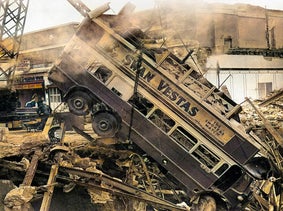A South London Shelter
Balham is an Underground station in central Balham in the London Borough of Wandsworth, south London, England. On the National Rail network it is 4 miles (7.5 km) from London Victoria.
Balham was one of the deep tube stations chosen to serve as a civilian air raid shelter during the Second World War and was a popular destination for those in the area sheltering from German bombs during the Blitz.
On 14th October, 1940, just before 8 o'clock, the dreadful, ominous scream of the air raid sirens started. Up to 600 passengers may have been crammed into the platforms at Balham, many of whom had brought bedding in case they needed to spend the night.
Around 10 p.m., a 1400 kg armour-piercing bomb detonated through Balham High St.'s surface, creating a massive crater nearly 50 foot wide and tearing off the fronts of nearby buildings. No one on board an out of service number 88 double-decker bus that crashed into the sizable crater was hurt although there are reports that the bus driver suffered concussion.

The size and extent of the damage caused by the bomb can clearly be seen in this photo.
The southbound platform tunnel was also flooded, and debris and water from the partially collapsed northbound platform tunnel's filling it with seven million gallons of soil and water from the broken water mains and sewers. Within minutes, the water nearly reached the main concourse, some 25ft above, and even reached within 100 yards of Clapham South station.
The explosion and the fall did not result in any fatalities among the 600 persons below. However, this flood was kept within by water-tight doors intended to keep similar floods out. The lights fused, increasing the chaos.
Although more than 400 people were eventually able to flee the panic-stricken station, 65 - or according to some accounts 68 individuals - perished in the accident, the most of them drowned.
The destruction to the nearby buildings can be seen in this picture.
(4) BabelColour (@StuartHumphryes) / Twitter
A close up of the damaged bus.
London Transport Museum Collection
From this angle, more of the damaged buildings close by can be seen.
London Transport Museum Collection
Sections of tram track are also visible among the debris. Workmen and others stand around the rim of the crater.
However, while some accounts claim that people drowned, others contend that everyone who died was a result of the panic among those attempting to exit the station.
The Commonwealth War Graves Commission (CWGC) estimates that sixty-six individuals died in the station; however, some sources claim that 64 shelter-seekers, four railroad employees, and more than seventy other people perished. The line was blocked to traffic due to damage at the track level.
This view shows a cross-passage at the station, almost filled with rubble.
The government tried to keep the details of the incident quiet as much as possible out of concern that the horrific deaths of so many people would damage its image and maybe discourage people from seeking safety in the underground.
The last remains were discovered at the end of December, but word of the killings quickly spread and the station wasn't reopened until January 1941. Following that, many people refrained from using it as a refuge due to the cold weather and their memories of the deceased.
This view is of the northbound platform, filled almost to the roof with rubble. The only features that can be recognised are a lightshade, a clock (stopped at 8.02pm, the time the bomb struck), and the upper part of the platform wall tiling (on right).
https://www.ltmuseum.co.uk/ Topical Press
his view, taken from inside the tunnel, shows how the track and much of the platform was buried in debris.
https://www.ltmuseum.co.uk/ Topical Press
People are still moving along the footway beneath as the double decker bus is removed from the bomb crater.
Memorial
In October 2000 a memorial plaque commemorating this event was placed in the station’s ticket hall.
It stated that 64 lives were lost, which differed from the CWGC register at the time, and other sources.
On 14 October 2010, this was replaced with a new commemorative plaque that does not state the number of fatalities.












